Shahara - The incredible city#
by Hasso Hohmann, February 2016In Yemen, in 1991/1992, people used for transport buses, minibuses, and small taxi-cabs within cities, and collective larger cabs at the exits of cities for longer trips. However, those vehicles had 4 narrow rows of seats and worst, they would start their trip only when every seat was filled.
Huth Huth, Yemen is a small town halfway between the capital Sanaa Sannaa, Yemen and Saada Saada, Yemen in the very North. In Huth we could only find cabs to take us to Gabai at the foot of the mountain range Shahara Shahara, Yemen that is crowned by the very unusual village of the same name located at the very top of the mountain ridge. This is what we intended to visit. Although the distance in kilometers is quite small the taxi drivers asked for a very hefty sum of money.
To continue from Gabai up the mountain by special cars is known to be both expensive and treacherous (as we could find out later ourselves). However, for the short distance to the foot of the mountain the amount that was asked for was ridiculous. Hence we started on foot along the road, hoping to pick up a ride for a bit of cash. We did not realize that there was almost no traffic on that road. We had some initial luck to find a car to take us to the next village, an hour's drive from Huth. But then we had to wait quite a long time, surrounded by curious kids. It was one hour later that the first car going the right direction came by. The driver, a local, was working on some agricultural project just 5 km form where we stood, direction Gabai. He promised to get some water for us and to return in ten minutes. A kind local offered us to have a bite in the cafeteria of a nearby school, but we decided to wait at the roadside as not to miss the opportunity to get further.
We saw many women in beautiful dresses, some with tight upper garments, their skirts at least covering their knees. Below this they were all wearing trousers, wore a black veil or one covered with red decorations, and on top of this a hat. Some were leading herds of sheep or goats. The animals very much liked the orange peels that we dropped to the floor!
After another half hour we found someone to take us even a bit beyond Gabei, to the village that is the usual starting place for tourists to take a wild drive on a four-wheeled Toyota steep uphill to the village Shahara. This ride covers some 1000 m of altitude at an (for Yemen) unaffordable price. It winds up the mountain side in an unbelievable way, and takes the tourists back the same route the next day.
However, we continued our trip for two more hours, and at the end paid a reasonable sum to the driver. Our aim was to climb up to Shahara and to visit the former fortification that was blocking the way through a canyon, the only route to reach Shahara village in former times. We also were curious to see the famous bridge at the upper end of another canyon, making Shahara village truly unconquerable in old times.
By now it was 3 p.m.: We had no time to loose: 1000 m of altitude on rough terrain seemed like quite a challenge. To find the old trail to Shahara we asked for directions. We went a short distance on a graveled road to a small village, but then we could not see how to continue. The persons we asked kept pointing in different directions to the terraces on the mountain side. A trail was nowhere in sight.
We noticed the houses made of stone, often decorated with colored natural stones in a complex fashion. It was also clear that color had been applied afterwards in a way to emphasize the natural forms of stones resulting in a very harmonious impression.
In contrast, the atmosphere emanating towards us from people working on the terraces was all but harmonious. All of them, even the women and children seemed to view us with animosity. Could it be connected to the change of weather that seemed to brew up a thunderstorm? An old, evil looking woman asked aggressively for "galam" (ball-point pen). Others wanted to force us to turn around. Still others pointed diagonally up.
In the few trees that grew in this area, children were sitting, breaking branches and dropping them as food for the animals. The goats seemed to be particularly fond of the leaves.
On the terraced fields mostly "kat" was harvested, a hallucinogenic plant. Kids were throwing stones at us, but also at locals! From the mountains we heard shots all the time, and the gun fire seemed to be answered from the valley. With all this hostility we were worried that the locals tried to point us in wrong directions. However, after we had crossed a few terraces the trail improved; our suspicions had been unfounded.
In the meantime the weather had further deteriorated. Clouds became more and more dense. In the distance we could hear thunder and saw sheets of rain hanging from the clouds. We tried to hurry up. In a number of places we could see small cisterns carved out from the rock; collecting water here was certainly important for both people and plants!
It was a long and steep way up. Our heavy rucksacks did not help, and Adele's general health problems reduced her usual fantastic sportive condition. I was watching out for cracks in the rock just in case we would have to hide from rain or even stay overnight.
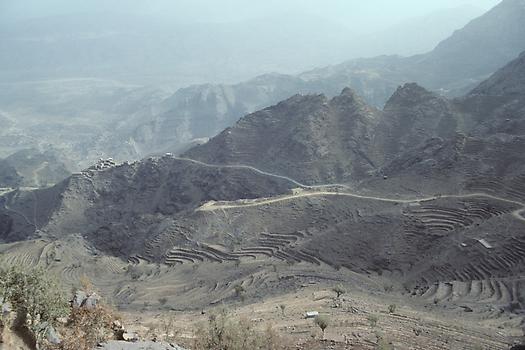
Terraced fields, under CC BY-SA 4.0

Terraced fields, under CC BY-SA 4.0
For quite a distance we walked along an almost vertical cliff on our right, giving us great views of the valley below on the other side. The terraces in the mountain-side almost gave the impression of a terrain-model, with the contour lines cut out of cardboard. We could see that we had gained quite a bit of height, with good views far into the distance, with small villages in the rugged landscape. Looking upward, from time to time traces of Shahara village were visible. It still seemed uncomfortable far up as it started to turn even darker, as the trail swerved to the right into a canyon with still less light.

View of multistory defense from above, under CC BY-SA 4.0
Rocks on both sides went up vertically. Then, suddenly, a multi-story fortress built of stone blocked the canyon side to side, with crenels and embrasures to shoot at attackers: a perfect construction of defense against intruders! We could enter the construction, walking up old flights of stairs, apparently not in use any more, since the road mentioned (as bad as it was) offered by now better access to the village.
The roof of the fortification was already cracking in many places. However, it was clear that at some stage many guards must have lived here. On a staircase integrated into the rock it evidently was once possible to also go a bit to the side to defend against attackers not just straight down but also from the side.
I have never in my life have seen such a short yet effective defensive construction before. Indeed, the city was conquered only once at the beginning of the 17. century, when it came under the domination of the Ottoman Empire. It appears the British only attacked the city from the air. It was certainly bombarded in 1962 by their own Yemenite air force. Some houses received much damage.
Shahara was always a place for desperate people to take refuge.
We continued our ascent. No visible trail was left, we walked carefully on sheer polished convex rock, devoid of any vegetation until we came to a few houses. They looked like spikes on a round sphere as they slowly became visible. It was now brighter than in the canyon. Children shouted again "galam" and women "funduk" (guesthouse) and where to continue
When Adele asked if we could stay here they did not like the idea and pointed once more in the direction they had shown before. When the trail started to go downwards, rather than up, we were unsure if we were heading the right direction. Had we misunderstood the directions? But then we saw the chasm and soon the famous bridge of Shahara. We had to climb many stairs in a zig-zag pattern, sometimes rock directly over our heads. We had to go quite a distance down, then through a door leading to the bridge and across it to the Shahara-village proper.
By now it was almost completely dark. The sun had gone down behind dense clouds of rain, and the clouds were hanging quite low. The view of the bridge was fascinating, if not ghostly. I had to take a photo! I made two long exposure photos of 30 seconds each, steadying the camera on rock. The pictures turned out to be quite impressive so that Austrian Airlines decided to print them in one of their magazines!
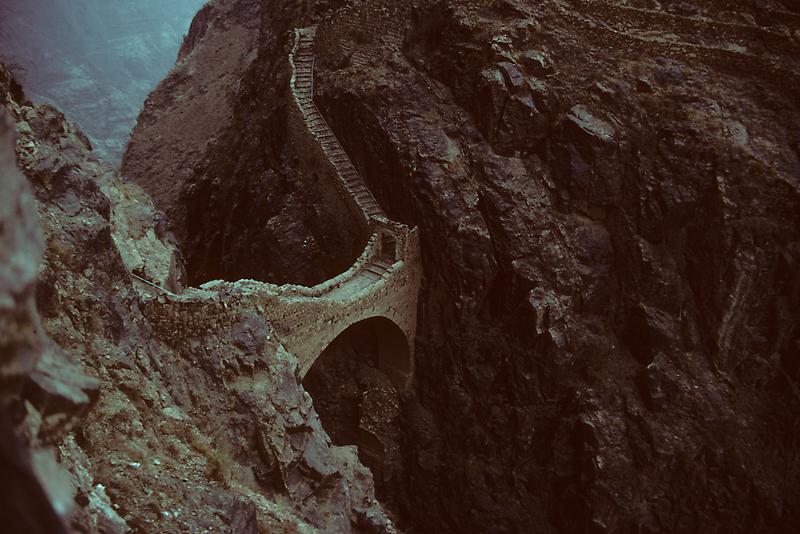
The famous bridge of Shahara. Parts of the older bridges visible below the current one, under CC BY-SA 4.0
In the pitch black night after stopping for the photo, an Italian couple lead by a local guide happened to come by. The guide had a miserable torch light, the battery at the end of its power. They were crossing the bridge after a short visit to the houses we had passed a bit earlier. The guide carried a Kalashnikov and had a pistol in his belt. We were allowed to follow them. This was critical, since no daylight was left. When the torch lamp dimmed more and more we could just make our way by groping and holding each others hands.
After arrival in Shahara we were first lead to the Funduk, the guesthouse. Adele stayed here with our rucksacks as I followed the guide to a small shop that was to close soon. The "store" was lit by a carbide lamp and it was made clear that even in the Funduk the light would soon be turned off.
I purchased a bit to drink and to eat. After our ascent we certainly had deserved this! There was no further light visible in Shahara. The silence was extreme to the extent that I thought I had gone deaf. The situation reminded me of a very early trip in a small one-person boat on the sea in dense fog, when I also had the feeling to be deaf. Even when shouting, nothing seemed to be reflected, but just swallowed by the fog.
The Funduk of Shahara is an old four-story house made of stone, with traditional bars, also made of stone, so-called Transennae, some of them with traces of glass between the bars. The entrance door was secured by one of the typcial "trap-mechanisms". The door had beautiful carvings.
The two-story inside had an open stairway between the floors. Further up the staircase divided, one going left, the other right. Our "bedroom" and "living room" was in the second floor up and looked like a Kat-room not further in use. There were long benches below the windows, and many niches with all kinds of stuff in them. The ceiling showed wooden beams and some beams across for stability. Looking outside no other light except the one from the Funduk was visible, the village was completely dark. The Funduk had light between 6 and 10 p.m. because of an electric generator.
The guesthouse was run by a 16 year old veiled Yemenite. She spoke Arabic, and some English, German, Italian and French. The evening meal was served in Yemenite tradition on a large tablet on the floor. Hot mint-tea was served a kind of sandy cake soaked in honey was offered as desert.
All other guests were Italians. They had reached the village as a group with two almost new Toyotas.
We were quite tired, exhausted and happy to still have reached our destination. Thus we were the first to lie down. We managed to get a small room that we had to share with just one other couple. For a short while before sinking into deep sleep we still heard the other Italians chatting, and rain hammering against the windows. We have had quite a bit of luck by reaching the Funduk and not getting soaked. We slept deep and without dreams.
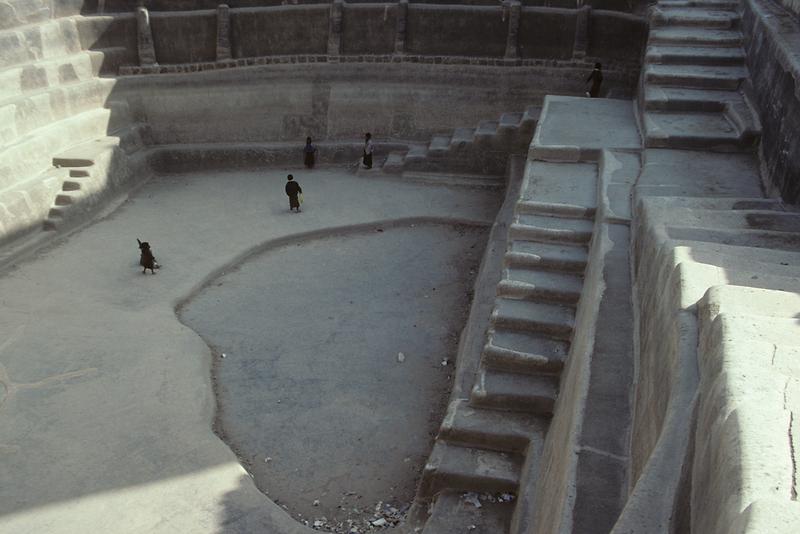
Main cistern of Shahara, under CC BY-SA 4.0
We rose at 7 a.m. next morning. The weather was good, so the sun welcomed us through the window. The night had been quite chilly: Some of the windows showed ice. Breakfast was tea and pita bread.
We then visited the city. At the center was a huge cistern which at that point in time was almost empty. It therefore showed its architectural appealing soft "negative sculpture". All steps were coated with some hard plaster to avoid water getting lost. This plaster assured that there were no sharp edges or such; everything was smoothly rounded.
This makes cleaning the cistern easy. There were two more big cisterns, one with an overflow-ditch to the other. In a smaller completely dry cistern kids were playing ball; playing here had the advantage that balls would not get lost by tumbling down the mountain side, as we observed in another location. There were many other small cisterns for individual houses or groups of houses.
Some of the beautiful constructed old stone houses showed the destruction bombs had caused, a reminder of the civil war in the 1960-ties. Most damage was apparently done by the Yemenite (!) air force in 1962.
The city extends to the surrounding ridges, some very narrow. Here the streets reduce to pathways where houses can be reached only by foot. The often multi-story houses look like extensions of the rocks on which they are erected. Since they are built from rock it is a fluid merging of nature and houses.
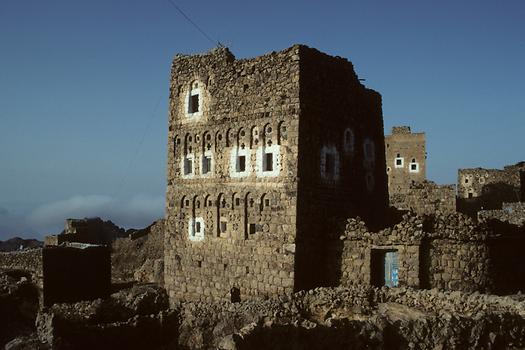
Complex decor with round, crosslike and rectangular windows, under CC BY-SA 4.0
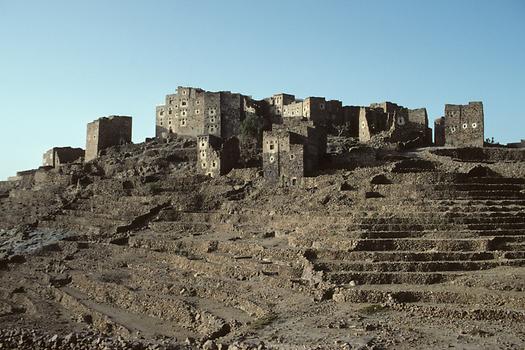
Visible damage from the civil war 1962, under CC BY-SA 4.0

This house also shows damage done by bombs, under CC BY-SA 4.0
As we walked once more to the bridge we could observe that the Italians were prevented from taking pictures by a local, threatening with his Kalashnikov. We waited a bit until the local had disappeared and then took a series of pictures of the bridge and the chasm it crosses.
Today's bridge was built in the 16-th century. However, remains of at least two earlier bridges can be detected. The bottom of the former bridges is located at a lower level. Traces of a pathway that led at some stage to those lower bridges are still visible. The 100 m deep gorge that could only be crossed on the bridge, itself protected by a solid gate, was the second line of defense against potential intruders from the valley. Note that anyone trying to cross the bridge could easily be shot at from the stairs leading upwards to the village!
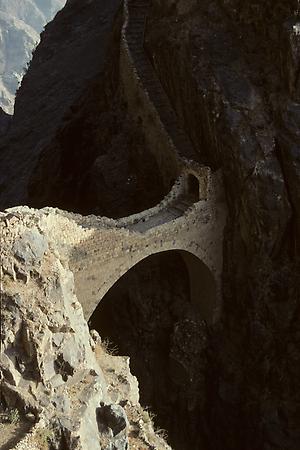
The famous bridge of Shahara in early morning sun, under CC BY-SA 4.0

The bride with the gate, under CC BY-SA 4.0

Bridge with gate from other side, under CC BY-SA 4.0
The Toyotas were supposed to take the Italians down at 9:15 a.m. Hence we came with our rucksacks to the gathering place, hoping to catch a ride. It turned out that one of the drivers was the guide whom we had met the preceding evening. Already in the evening he had shown some respect and fondness for us because of our ascent by foot on a not-so-easy route. When he saw us, he welcomed us like old friends.
When we asked if we could get a payed ride down he agreed, and asked as price exactly half of the "return fare". I argued that going down he needs no gasoline, has no engine-wear, just a bit load on the brakes. He asked what we thought we should pay. I mentioned one fifth of the price. With a big smiling face, without further negotiation and a loud "tamam" (let it be) he agreed.
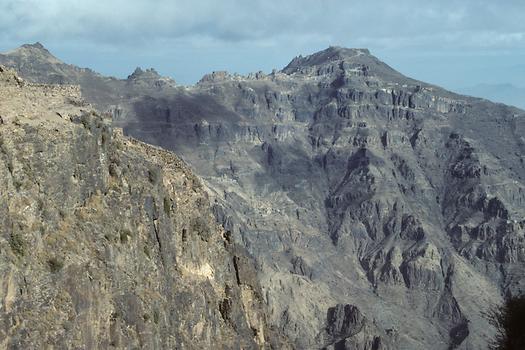
The houses seem to grow on the rock, under CC BY-SA 4.0
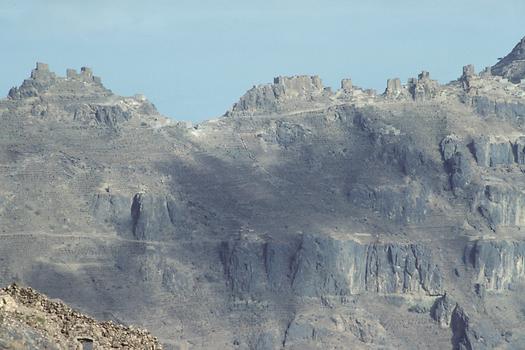
The spikes on then mountain ridge are not rock, but houses built with stones (zoom in to verify!), under CC BY-SA 4.0
The drive down was impressive, if not frightening. I have never seen such a steep road. In the gorges and chasms on both sides one could see the wreck of quite a few cars, evidence that sometimes brakes had failed. The cars were almost unable to keep traction on the steepest parts of the road. It is hard to believe that this road is considered drivable. In some places the curves are so tight that only by backing up they can be managed. (By the way, a few years later the road was closed for touristic purposes because of the danger involved).
Anyway, at 10:15 a.m. we reached the small village we had passed on the day before.
Here the tourists were supposed to change cars. All cars, the two "mountain Toyotas" and the Rovers to continue were in a closed space between buildings, with a single exit. We paid the agreed price. One of the Italians must have seen this. As a consequence, the Italians also wanted to pay less.
This was embarrassing for us and I offered the driver to pay more. But he laughed and said "tamam" is "tamam"-- agreed is agreed. Since the Yemenites insisted that the Italians pay what they had agreed to pay, the Italians tried to solve the problem by just putting the smaller amount on the table and jumped into the Rovers to depart without agreement.
However, two locals prevented this lightning fast by aiming their Kalashnikovs at the Italians. At the same time others blocked the exit with the two Toyotas. This action was carried out with perfection; it must have been practized before!
Now the Italians paid, pale because of the shock, thanked profusely and seemed to be happy to get off without further problems.
Our driver gave us a very cordial goodbye. Everyone was friendly again and the Italians clearly relieved. When our driver very sternly demanded that the Italians take us along to Huth they agreed.
Along the road there where many bottle-trees, a protected plant in Yemen. The rest of the vegetation are Cacti and thorny bush. We observed that goats climbed high up into the tress, something I have never seen goats do before. They tried to get some of the hard leaves too high to reach from the ground. Yes, Yemen is a barren and hard land, for men, animals and plants.
We arrived in Huth at 12:45 and wished the Italians a good further trip. They were still a bit under shock; during the whole trip they had talked much less than what one would expect of Italians.
See also the two sections on Schahara in the excellent book about Jemen: